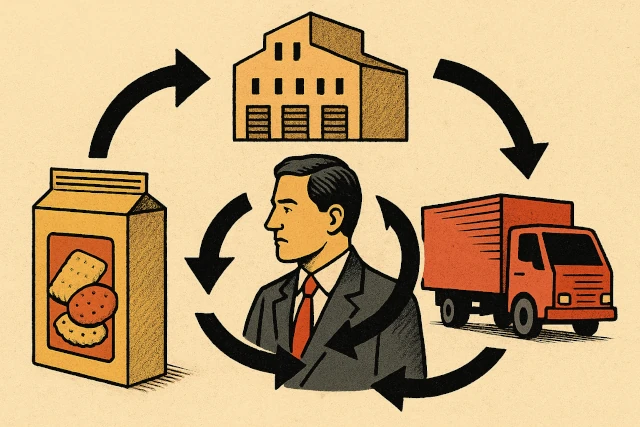When to Use a Distributor: A Guide for CPG Brands

Hey there! I’m Sam — a CPG lifer who’s spent over 15 years knee-deep in food and beverage. I’ve launched my own brands, hustled as a broker, wrangled with distributors, and built sales from the ground up. One of the biggest questions I get from other founders is: "Should I use a distributor?"
The answer? Well, it depends.
In this guide, I’ll walk you through what distributors actually do, how they stack up against brokers and inside sales, and when it makes sense to team up with one — or steer clear. Let’s dive in.
What’s the Difference? Distributor vs. Broker vs. In-House Sales
First off, let’s break down the main players in the CPG sales and distribution game. There’s a lot of confusion out there about what each of these roles actually does — and why it matters. Here’s a quick rundown:
Distributor: These folks actually buy your product, stash it in their warehouse, and sell it to stores. They deal with storage, shipping, and logistics headaches so you don’t have to. Big names include UNFI, KeHE, and regional players like Neal Brothers or Horizon.
Broker: Think of brokers as your sales reps-for-hire. They don’t touch your product, but they’ll hustle it into retailers for a cut (usually 5-7%). They’re all about relationships and door-opening.
In-House Sales (DSD or Inside Sales): You or your team are doing everything — pitching, following up, closing deals, sometimes even hand-delivering cases. Tons of control, but it takes serious time and energy.
The Pros of Using a Distributor
Alright, so what’s great about using a distributor? Here are some of the biggest reasons founders bring one on board:
- They open doors: Some retailers just won’t work with you unless you’re in a specific distributor’s system. This gets you in.
- They make things easier: Instead of delivering to 20 stores, you deliver to one warehouse. Less hassle, more time for building your brand.
- No warehouse? No problem: They handle storage, inventory, and shipping. That’s a lot off your plate.
- You can grow faster: Distributors help you scale up in new regions without hiring a local ops team right away.
- Street cred: A good distributor can help you look more legit to retailers, especially if you’re new.
The Cons of Using a Distributor
Of course, distributors aren’t all sunshine and rainbows. There are definitely some tradeoffs you need to know about before diving in:
- Your margins take a hit: They’re taking 20–35% off the top. That stings — especially when you add in promos, broker fees, and more.
- You’re not in control: Just because your product is in their system doesn’t mean they’re actively selling it.
- Spoilage risk: If your product sits too long in their warehouse, it might go bad — or they might ask you to pay for it.
- Slow pay: Expect to wait 45–90 days to get paid, even though you already paid for production upfront.
- Sales still fall on you: Distributors deliver; they don’t create demand. You still need to hustle.
When to Use a Distributor
Let’s talk about the kinds of situations where using a distributor is actually a smart move. Here are a few times when it makes sense to bring one into the fold:
- You landed a chain deal: If a retailer like Farm Boy or Save-On-Foods says yes — and they only order through certain distributors — well, there’s your answer.
- You’re growing out of your backyard: If you're expanding into new regions and can’t physically manage deliveries, it’s time.
- You’ve got real volume: If you’re pushing $20k+ a month in retail sales in one area, a distributor might save you time and money.
- Your product has a long shelf life: The longer it lasts, the less risky it is for the distributor and for you.
- Your team is maxed out: If you’re spending more time packing boxes than growing your brand, that’s a red flag.
When You Should NOT Use a Distributor
And just as important — here’s when you should seriously pump the brakes before partnering with a distributor. These red flags are easy to ignore but crucial to consider:
- You’re still testing things out: If you haven’t nailed product-market fit yet, don’t scale. Keep it scrappy.
- Your margins are razor-thin: If you’re already tight, a distributor can make your business model unsustainable.
- You’re only in a few stores: If you can handle orders yourself, do it. You’ll learn way more and keep more money.
- Your product needs hands-on education: If you need to explain what your product even is, a distributor won’t help with that.
- Your product doesn’t travel well: Cold, fresh, fragile — these make distribution expensive and risky.
Checklist: Should You Work With a Distributor?
Still on the fence? Here’s a gut-check list to help you think it through. If you're nodding along to most of these, it might be go-time:
- ✅ Do I have enough demand to justify this?
- ✅ Can I handle losing 25–30% of my wholesale price?
- ✅ Is my product shelf-stable and easy to move?
- ✅ Am I clear that they won’t do my selling for me?
- ✅ Have I maxed out my direct and broker options?
- ✅ Am I okay with slower payments and more paperwork?
- ✅ Do I have a plan to support retail sales and drive velocity?
If you nodded along to most of those — especially the top three — then yeah, it might be time.
Final Thoughts
Distributors can be a rocket booster for your brand — or a money pit if you jump in too soon. The best brands I’ve seen built demand first, then plugged in distribution when the timing was right.
If you're ready to get going, here's our list of 150+ distributors with contact info so that you easily get in touch with them - OR - chat with me and we can discuss the best fit for you and your brand.
Still not sure? Test small. Try a regional partner, watch what happens, and don’t be afraid to pull the plug if it’s not working. At the end of the day, no one will ever care about your product like you do. So stay close, stay scrappy, and keep selling.












